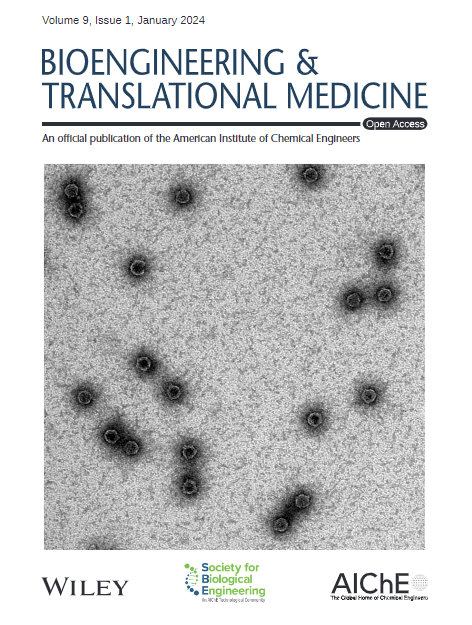A silicon membrane microfluidic oxygenator for use as an artificial placenta with minimal anticoagulation
IF 6.1
2区 医学
Q1 ENGINEERING, BIOMEDICAL
引用次数: 0
Abstract
Extreme prematurity carries a high burden of morbidity and mortality. The artificial placenta is an emerging therapy that has the potential to improve outcomes in these patients. However, current devices in development are limited by inadequate hemocompatibility, a major barrier to the translation of the artificial placenta into humans. Here, we present a novel microfluidic oxygenator that is comprised of a stacked array of semiconductor silicon membranes and operates with minimal anticoagulation (activated clotting time = 120–180 s). We describe the design, construction, and testing of two generations of prototypes. Our Generation 2 Device had an oxygen transfer of 1.51 ± 0.25 volume % (mean ± standard error). Computational fluid dynamics (CFD) modeling demonstrated favorable blood flow properties, including laminar flow, no stasis or recirculation, and optimal wall shear stress. In vivo testing in a 6 hour neonatal swine model showed that the silicon membrane oxygenator could operate with low‐dose anticoagulation with minimal clot formation. Furthermore, the oxygenator had no significant effect on markers of animal health, including inflammation (white blood cell count), coagulation (platelet count, prothrombin time), or hemolysis (hematocrit, plasma free hemoglobin). This study represents a key advance toward developing an anticoagulation‐free oxygenator and ultimately bringing artificial placenta technology to patients.一种硅膜微流控充氧器,用于具有最小抗凝作用的人工胎盘
极端早产带来很高的发病率和死亡率。人工胎盘是一种新兴的治疗方法,有可能改善这些患者的预后。然而,目前正在开发的设备受到血液相容性不足的限制,这是人工胎盘移植到人体内的主要障碍。在这里,我们提出了一种新型的微流控氧合器,它由半导体硅膜堆叠阵列组成,具有最小的抗凝作用(激活凝血时间= 120-180秒)。我们描述了两代原型的设计、构造和测试。我们的第二代设备的氧传递率为1.51±0.25体积%(平均值±标准误差)。计算流体动力学(CFD)模型显示了良好的血流特性,包括层流,无停滞或再循环,以及最佳的壁面剪切应力。在一个6小时的新生猪模型中进行的体内试验表明,硅膜氧合器可以在低剂量抗凝血的情况下工作,并且形成最小的凝块。此外,氧合剂对动物健康指标没有显著影响,包括炎症(白细胞计数)、凝血(血小板计数、凝血酶原时间)或溶血(红细胞压积、血浆游离血红蛋白)。这项研究代表了开发无抗凝氧合器的关键进展,并最终将人工胎盘技术应用于患者。
本文章由计算机程序翻译,如有差异,请以英文原文为准。
求助全文
约1分钟内获得全文
求助全文
来源期刊

Bioengineering & Translational Medicine
Pharmacology, Toxicology and Pharmaceutics-Pharmaceutical Science
CiteScore
8.40
自引率
4.10%
发文量
150
审稿时长
12 weeks
期刊介绍:
Bioengineering & Translational Medicine, an official, peer-reviewed online open-access journal of the American Institute of Chemical Engineers (AIChE) and the Society for Biological Engineering (SBE), focuses on how chemical and biological engineering approaches drive innovative technologies and solutions that impact clinical practice and commercial healthcare products.
 求助内容:
求助内容: 应助结果提醒方式:
应助结果提醒方式:


